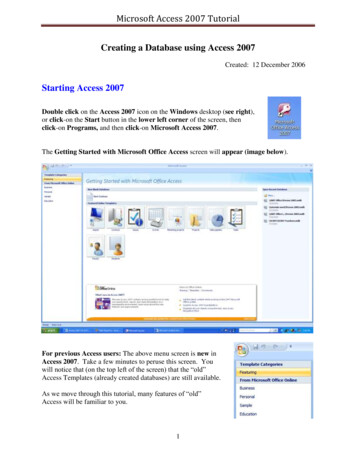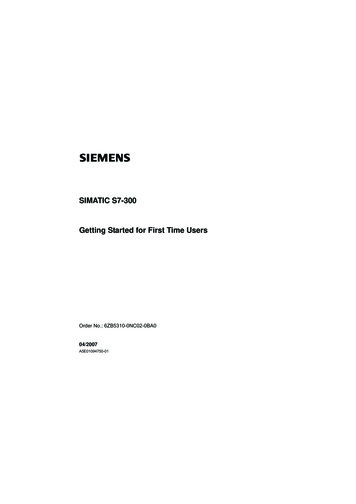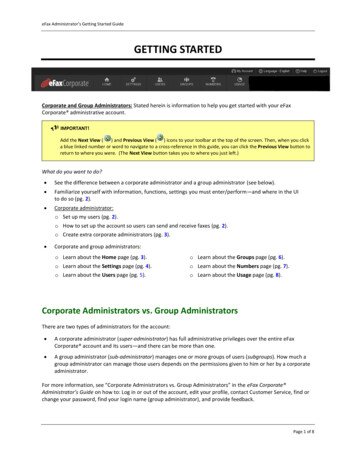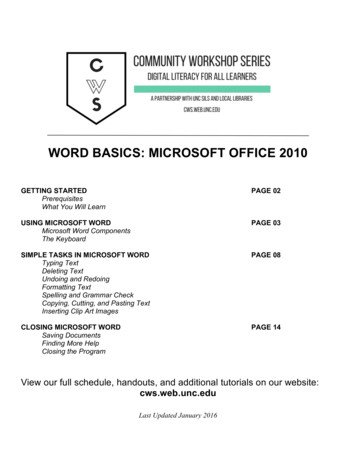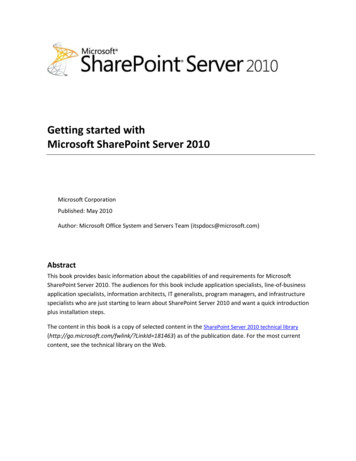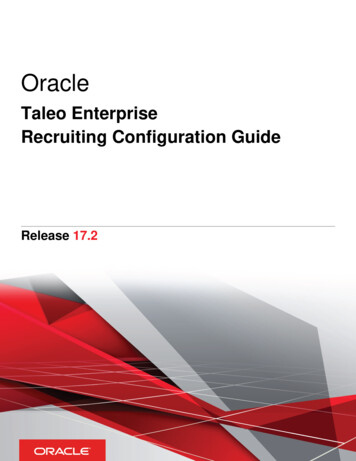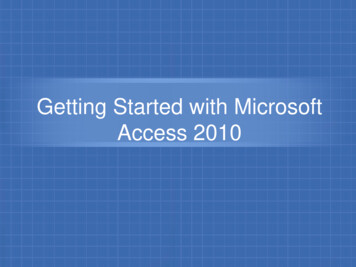
Transcription
Getting Started with MicrosoftAccess 2010
Learning Objectives What is Microsoft AccessWhat is DatabaseWhat are the Access ObjectsStart AccessIdentify parts of the Access interfaceCreate and save a databaseOpen and close an existing database
What is Microsoft Access?Microsoft Access is a relational database management system(DBMS or RDBMS). At the very core, it is a software “engine”that provides an interface between physical data and userapplication queries.Other examples of DBMS applications include: Oracle My SQL SQL Server (Microsoft) DB2 (IBM)
What is database A database can best be described as a way of storing largeamounts of information. The data can be retrieved and we caneven ask questions of the data and get answers. A database is an organized collection of records. Microsoft Access is a database software package. Telephone and address books are examples of paperdatabases.
Access Objects Tables Queries Forms Reports Macros Modules
Access Objects Tables:- In Access, data is stored in tables. A table is a set ofcolumns and rows, with each column referred to as a field.Each value in a field represents a single type of data. Eachrow of a table is referred to as a record. Queries:- You use queries to retrieve specific data from yourdatabase and to answer questions about your data. Forexample, you can use a query to find the names of theemployees in your database who live in a particular state. Forms:- Forms give you the ability to choose the format andarrangement of fields. You can use a form to enter, edit, anddisplay data.
Access Objects Reports:- Reports organize or summarize your data soyou can print it or view it onscreen. You often use reportswhen you want to analyse your data or present your datato others. Macros:- Macros give you the ability to automate tasks. You can use amacro to add functionality to a form, report, or control. Modules:- Like macros, modules give you the ability to automatetasks and add functionality to a form, report, or control. Macros arecreated by choosing from a list of macro actions, whereas modules arewritten in Visual Basic for Applications.
Why choose MS-Access over SPSS / Excel? MS Access is best used for long-term data storage and/or datasharing. MS Excel is best used for minor data collection, manipulation,and especially visualization. SPSS is best used for minor data collection and especiallydata analysis.It is easy to export data from MS Access to Excel SPSS
Microsoft Access Access 2007, 2010 and 2013 databases end with.accdb file extension – for example, sales.accdb Databases made in older versions of Access have thefile extension .mdb NEVER remove a disk or flash drive until Access iscompletely shut down.
Working with Access
Starting Access3421
Access WindowThe Access window appears as shown
Parts of the Access interfaceTitle BarMain MenuQuick Access Tool BarStatus BarRibbon
Creating a DatabaseA database can be created by using The Blank Database command– Used to create a blank database– All other database objects should be createdmanually Using Templates– Used to create tables, forms, queries and reports byReadymade files
Creating a Database (Contd.)1To create a database by using the Database Wizard324
Access Window componentsDocuments tabs barViewsDesign ViewsTable Datasheet ViewTable Design ViewWe should Save the table with a table NameField Properties
Creating Tables – From the Create Tab Enter table data directly in fields– From the Create Tab, click Table DesignEnter datadirectly into atable, includingthe field namesEnter field names,data types anddescriptions inTable Design View
Creating Tables – Specifying field namesTableViewAdd fieldinTable ViewTable DesignView After choosing your method of creation beginimplementing the table design– Use CamelCase notation for field names– Specify data types– Establish a primary key
Understanding Data TypesSettingType of dataSize(Default) Text or combinations of text andnumbers, as well as numbers that don'tTextUp to 255 charactersrequire calculations, such as phonenumbers.Lengthy text or combinations of text andMemoUp to 63,999 charactersnumbers.Numeric data used in mathematicalNumber1, 2, 4, or 8 bytescalculations.Date and time values for the years 100Date/Time8 bytes.through 9999.CurrencyCurrency values and numeric data8 bytes.A unique sequential (incremented by 1)number or random number assigned by4 bytes (16 bytes if theAutoNumber Microsoft Access whenever a new record is FieldSize property is set toadded to a table. AutoNumber fields can't Replication ID).be updated.
SettingType of dataSizeYes/NoYes and No values and fields that containonly one of two values (Yes/No, True/False,or On/Off).1 bit.OLE Object An objectHyperlinkText or combinations of text and numbersstored as text and used as a hyperlinkaddress (hyperlink address: The path to adata type can contain up todestination such as an object, document, or 2048 characters.Web page. A hyperlink address can be a URL(address to an Internet or intranet site) page.Attachment Any supported type of fileLookupWizardUp to 1 gigabyte (limited byavailable disk space)Creates a field that allows you to choose avalue from another table or from a list ofvalues by using a list box or combo box.You can attach images,4 bytes.
Creating Tables – Data TypesSet the data type Define columns in the Design View
Primary KeyPrimary Key FieldPrimary Key icon Tables are automatically created with anAutoNumber field which serves as the primary key To change the primary key– Select a field in Design View– Click the primary key icon
RelationshipsTo create a true relationship one field in therelationship must be the Primary Key or indexed,no duplicates field ; this ensures at least one sideof the relationship is unique.Access is not particular a bout the spelling of thefieldnames, but the data type and field size mustbe the same.
Types of RelationshipsOne‐to‐manyThe most common relationship you will probablycreate will be a one‐to‐many. This is a linkbetween a Primary Key field and a non‐PrimaryKey field.
One‐to‐oneOne‐to‐oneThe other true relationship you can create inAccess is a one‐to‐one relationship. This is a linkbetween a Primary Key field and a matchingPrimary Key field in the second table
Many‐to‐ManyMany‐to‐ManyOften you will find that you have a many‐to‐manyrelationship
What is Microsoft Access? Microsoft Access is a relational database management system (DBMS or RDBMS). At the very core, it is a software "engine" that provides an interface between physical data and user application queries. Other examples of DBMS applications include: Oracle My SQL SQL Server (Microsoft) DB2 (IBM)

